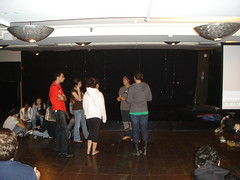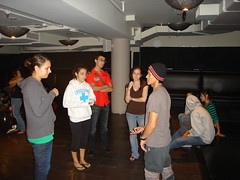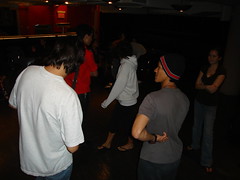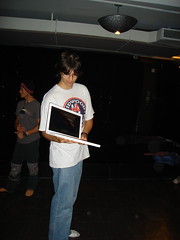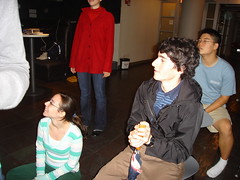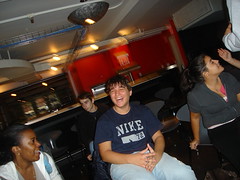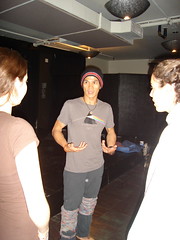Dante Adela Lecture 9/25/08
> Volume One, Issue 27, March 23 - 29, 2007
>
> GAGA in motion at Cedar Lake Dance
> Gaga for GAGA dance
>
> By Lisa Santandrea
> There are just five of us on the first day of class: two
> men, three women. One arrived by the suggestion of a trusted
> yoga instructor, others were enticed by a mysterious e-mail
> announcement: GAGA classes at Cedar Lake Dance in Chelsea,
> taught by dancers of Israel’s famed Batsheva Dance
> Company. We sit on the floor of the stage, facing Shani
> Garfinkel, our GAGA instructor. “We won’t stop until
> it’s over,” she informs us, then quickly reassures,
> “but nothing should hurt.”
> She jumps to her feet: “Okay!” We rise, appropriating
> the expectant poses of those schooled in following the
> leader. Of course, we’ll follow, but what? Will the
> demands of GAGA be aerobic in nature? Will it require
> yogi-like stretches and precision, or a Joseph
> Pilates-inspired focus on the core? Music by the downtempo
> UK band, Zero7, fills the room.
> GAGA begins in the hands. Following Garfinkel’s lead, we
> stretch our fingers, separate them, move them in circles,
> arch and bend. Then the wrists are added to the cycle of
> circles, which eventually takes over our shoulders, ankles,
> our torsos and toes. Directions are definitively
> non-precise, often combined with images designed to evoke
> feeling, such as “You’re in a cold shower. Let the water
> run over you.” Each student develops his or her own
> groove, arms overhead, bodies gyrating. We have become a
> room of acid-tripping dancers in a ’60s B-movie.
> “Imagine looking at yourself from above,” Garfinkel
> instructs at one point. “Notice how silly you look. Take
> pleasure in it,” she adds, guiding us toward complete
> abandon. It is an eye-opening instruction: Whatever we’re
> doing, we’re doing it right. The sudden realization that
> we’ve become an undulating mass driven by our body’s
> desire to move is a shocker. It also seems to be the
> point of GAGA — that, and the pleasure of it all.
> GAGA is the creation of Ohad Naharin, artistic director of
> the Batsheva Dance Company. The name itself, GAGA, means
> nothing. “We used to call it the ‘language of Ohad
> Naharin,’” Garfinkel explains, “and that just was
> shortened to GAGA.” The company was formed in 1964 by
> Martha Graham and Batsheva de Rothschild. A protégé of
> Graham’s, Naharin became artistic director in 1990. His
> company’s performances have been heralded as vibrant
> masterpieces of mystery and sensuality.
>
> In June, dancers from the Cedar Lake Contemporary Ballet
> will perform Naharin’s “Decadance,” a program of
> reconstructed excerpts from ten works created between 1985
> and 2006.
> For Batsheva dancers, GAGA is essential daily practice.
> Garfinkel describes it as “training yourself to release
> movement potential.” “It’s not a physical
> challenge,” she explains. Instead, “it’s a combination
> of the passion to move, the effort and the pleasure.” It
> began 20 years ago when Naharin was providing choreography
> for Batsheva dancers. After a serious back injury, he
> explained by e-mail, “I needed two things: to get my body
> to move a little bit and also to be able to give other
> people the keys to the way to move in my work.” In the
> process, “I developed an awareness that had to do with
> finding where in my body I’m not hurting and where in my
> body I have unused muscles, unused movement.” Eventually,
> through continued communication of such movement to his
> dancers, “it became a language and a method.” For
> professional dancers, Naharin considers GAGA “higher
> education.” He says, “The important idea is to make
> people
> excel in the method they already know.
>
> It’s not to abolish or cancel or change their techniques.
> If someone wants to be a ballerina, then GAGA can help her
> to be a ballerina.”
> Providing GAGA instruction to non-dancers happened
> “almost as a joke,” says Naharin. About ten years ago,
> he began providing twice-a-week instruction to five
> non-dancers who worked for Batsheva. “Very quickly, I
> learned a lot about movement, movement habits… but in a
> new light because none of them had the ambition to be on
> stage. They just wanted to feel better, and to move better
> and to get stronger. So then GAGA became something that had
> nothing to do with the performing arts, just with the
> maintenance of your body — healing your body, finding
> pleasure and joy in movement. That became a very serious
> thing in my life — working with non-dancers. Today [in
> Israel] we have a venue with hundreds of non-dancers who
> come to take GAGA classes.” The classes at Cedar Lake,
> which began earlier this month, are the first he’s offered
> in the U.S.
> There is no “script” for a GAGA session. Although
> Garfinkel aims to create a few movements in which effort is
> maximized, the impetus is on creating an experience in which
> one can let go. For that reason, there are no mirrors in the
> room. When asked if this is intentional, she nods
> emphatically. “It doesn’t matter what it looks like from
> the outside.”

